Africa Wild Insect Book: Moths (Lepidoptera)
Moderator: Klipspringer
AW Insect Book: Moths (Lepidoptera) Noctuidae Agaristinae
Agaristinae is a subfamily of noctuoid moths, placed in family Noctuidae. The adults are called "Day Moths" because they fly in daylight hours. In this way they differ from most other moths. The adult moths are distinctively marked.
Africa Wild Insect Book: Moths (Lepidoptera)
Trimen's False Tiger Agoma trimenii
Family: Noctuidae. Subfamily: Agaristinae
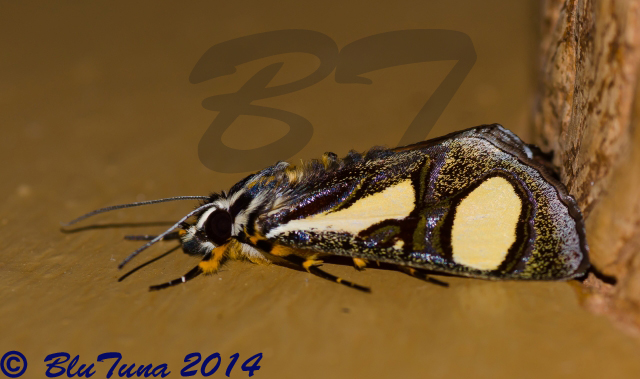 © BluTuna
© BluTuna
Kruger National Park, Crocodile Bridge Camp
Description
A very vwriable moth with bright orange hindwings.
Distribution
DRCongo, Ethiopia, Gambia, Kenya, Niger, Nigeria, Malawi, Mozambique, Senegal, Sierra Leone, Somalia, South Africa, Sudan, Togo, Uganda, Zambia, Zimbabwe.
Links: African Moths
Family: Noctuidae. Subfamily: Agaristinae
 © BluTuna
© BluTunaKruger National Park, Crocodile Bridge Camp
Description
A very vwriable moth with bright orange hindwings.
Distribution
DRCongo, Ethiopia, Gambia, Kenya, Niger, Nigeria, Malawi, Mozambique, Senegal, Sierra Leone, Somalia, South Africa, Sudan, Togo, Uganda, Zambia, Zimbabwe.
Links: African Moths
AW Insect Book: Moths (Lepidoptera) Noctuidae Agaristinae
Butler's False Tiger Heraclia butleri
Family: Noctuidae. Subfamily: Agaristinae
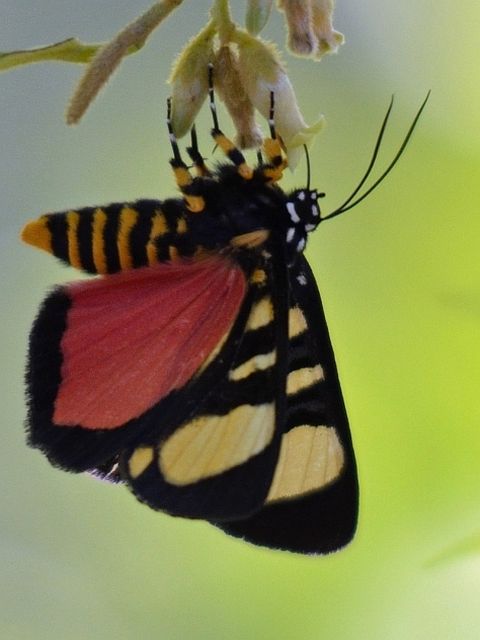 © BluTuna
© BluTuna
Kruger National Park
Description
A beautifully coloured day-flying moth. Wingspan: 60 mm.
Distribution
DR Congo, Malawi, South Africa, Tanzania, Zambia, Zimbabwe.
Links: African Moths
Family: Noctuidae. Subfamily: Agaristinae
 © BluTuna
© BluTunaKruger National Park
Description
A beautifully coloured day-flying moth. Wingspan: 60 mm.
Distribution
DR Congo, Malawi, South Africa, Tanzania, Zambia, Zimbabwe.
Links: African Moths
Hunting cannot be considered a sport as all contestants in a sport should know they are playing the game!
AW Insect Book: Moths (Lepidoptera) Noctuidae Agaristinae
Cream Cake, Sleepy Tiger Ovios capensis
Family: Noctuidae. Subfamily: Agaristinae
 © BluTuna
© BluTuna
Kruger National Park, Pretoriuskop
Description
Forewing olive green and white with small red dots on black edge, latger black-edged red spots in the centre. Hindwing yellowish with macular black outer band and a lunar black disk spot.
Distribution
Kenya, Malawi, Mozambique, South Africa, Swaziland, Zambia, Zimbabwe
Links: African Moths
Family: Noctuidae. Subfamily: Agaristinae
 © BluTuna
© BluTunaKruger National Park, Pretoriuskop
Description
Forewing olive green and white with small red dots on black edge, latger black-edged red spots in the centre. Hindwing yellowish with macular black outer band and a lunar black disk spot.
Distribution
Kenya, Malawi, Mozambique, South Africa, Swaziland, Zambia, Zimbabwe
Links: African Moths
AW Insect Book: Moths (Lepidoptera) Noctuidae Catocalinae
Catocalinae is a subfamily of noctuoid moths, placed in family Noctuidae. In the alternative arrangement, where Noctuidae are reduced to the core group around the Noctuinae, the present lineage is abolished, the upranked Catocalini being merged with the Erebini and becoming a subfamily of the reestablished family Erebidae.
Many of the species are large (7 to 10 cm) and have brightly colored hind wings. Hind wings have a terminal black spot and fringes between the M3 and Cu1 vein of the wings. The forewing mostly unimpressive black, grey or brown.
The Caterpillars of Catocalinae are usually smooth, lacking obvious hairs.
Many of the species are large (7 to 10 cm) and have brightly colored hind wings. Hind wings have a terminal black spot and fringes between the M3 and Cu1 vein of the wings. The forewing mostly unimpressive black, grey or brown.
The Caterpillars of Catocalinae are usually smooth, lacking obvious hairs.
AW Insect Book: Moths (Lepidoptera) Noctuidae Catocalinae
Echo Moth Achaea echo
Family: Noctuidae. Subfamily: Catocalinae
or: Family: Erebidae. Subfamiy: Calpinae
 © BluTuna
© BluTuna
Garden in Randburg
Distribution
It is found from Equatorial West Africa to Zimbabwe, including Sierra Leone, Ghana, Swaziland and South Africa.
Biology
A fruit-piercing moth.
The larvae feed on Poaceae and Panicum species, but have also been recorded on Citrus.
Links: African Moths
Family: Noctuidae. Subfamily: Catocalinae
or: Family: Erebidae. Subfamiy: Calpinae
 © BluTuna
© BluTunaGarden in Randburg
Distribution
It is found from Equatorial West Africa to Zimbabwe, including Sierra Leone, Ghana, Swaziland and South Africa.
Biology
A fruit-piercing moth.
The larvae feed on Poaceae and Panicum species, but have also been recorded on Citrus.
Links: African Moths
Hunting cannot be considered a sport as all contestants in a sport should know they are playing the game!
AW Insect Book: Moths (Lepidoptera) Noctuidae Catocalinae
White Chain Moth Calesia zambesita
Family: Noctuidae. Subfamily: Catocalinae
or: Family: Erebidae. Subfamiy: Calpinae
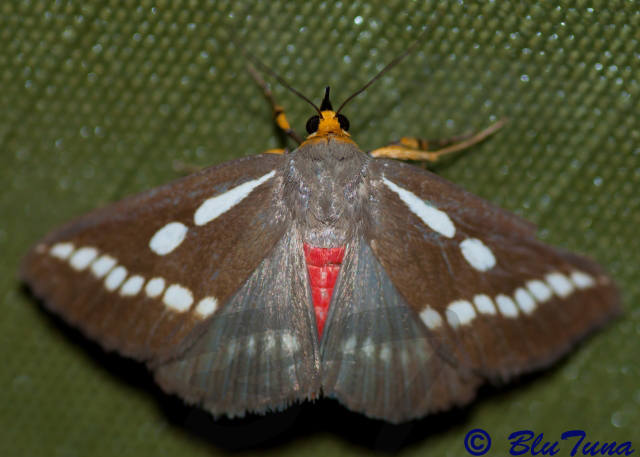 © BluTuna
© BluTuna
Kruger National Park, Tsendze camp
Description
Head and fore part of thorax orange. Abdomen crimson above. Fore wings with a white streak extending in the disk from the base, with a white spot in a line with the streak, and with an exterior oblique band of eight white spots. Hind wing with indistinct spots.
Distribution
Angola, Botswana, Kenya, Malawi, Mozambique, Somalia, South Africa, Tanzania, Zambia, Zimbabwe.
Biology
Larval foodplants: Dyschorista thunbergiiflora, Thunbergia erecta
Links: African Moths
Family: Noctuidae. Subfamily: Catocalinae
or: Family: Erebidae. Subfamiy: Calpinae
 © BluTuna
© BluTunaKruger National Park, Tsendze camp
Description
Head and fore part of thorax orange. Abdomen crimson above. Fore wings with a white streak extending in the disk from the base, with a white spot in a line with the streak, and with an exterior oblique band of eight white spots. Hind wing with indistinct spots.
Distribution
Angola, Botswana, Kenya, Malawi, Mozambique, Somalia, South Africa, Tanzania, Zambia, Zimbabwe.
Biology
Larval foodplants: Dyschorista thunbergiiflora, Thunbergia erecta
Links: African Moths
Hunting cannot be considered a sport as all contestants in a sport should know they are playing the game!
AW Insect Book: Moths (Lepidoptera) Noctuidae Catocalinae
Wavy Owl Moth Calliodes pretiossima, Calliodes rivuligera
Family: Noctuidae. Subfamily: Catocalinae
or: Family: Erebidae. Subfamiy: Ebreinae
 © BluTuna
© BluTuna
Kruger National Park
Distribution
DRCongo, Gambia, Kenya, Malawi, Mauritania, Mozambique, South Africa, Tanzania, Uganda, Zambia, Zimbabwe.
Habitat
Found in bushveld (savannah) and forest habitats around the north western and eastern regions.
Links: African Moths
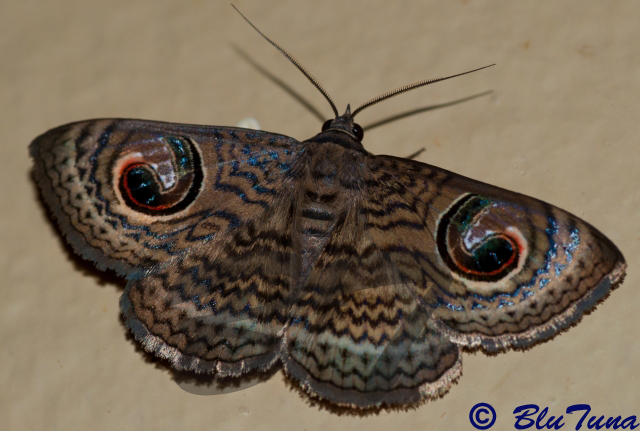 © BluTuna
© BluTuna
Kruger National Park, Maroela camp
Family: Noctuidae. Subfamily: Catocalinae
or: Family: Erebidae. Subfamiy: Ebreinae
 © BluTuna
© BluTunaKruger National Park
Distribution
DRCongo, Gambia, Kenya, Malawi, Mauritania, Mozambique, South Africa, Tanzania, Uganda, Zambia, Zimbabwe.
Habitat
Found in bushveld (savannah) and forest habitats around the north western and eastern regions.
Links: African Moths
 © BluTuna
© BluTunaKruger National Park, Maroela camp
Hunting cannot be considered a sport as all contestants in a sport should know they are playing the game!
AW Insect Book: Moths (Lepidoptera) Noctuidae Catocalinae
Vermiculous Cerocala vermiculosa
Family: Noctuidae. Subfamily: Catocalinae
or: Family: Erebidae. Subfamily: Erebinae
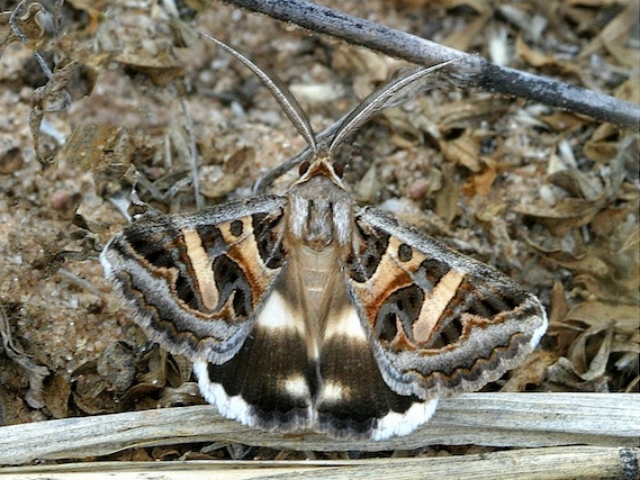
Nossob Walking Trail (November), Kgalagadi Transfrontier Park
Distribution
Botswana, Madagascar, Mozambique, Namibia, South Africa, Zambia, Zimbabwe.
Family: Noctuidae. Subfamily: Catocalinae
or: Family: Erebidae. Subfamily: Erebinae

Nossob Walking Trail (November), Kgalagadi Transfrontier Park
Distribution
Botswana, Madagascar, Mozambique, Namibia, South Africa, Zambia, Zimbabwe.
AW Insect Book: Moths (Lepidoptera) Noctuidae Catocalinae
Faint Owl Cometaster pyrula
Family: Noctuidae. Subfamily: Catocalinae
or: Family: Erebidae. Subfamiy: Ebreinae
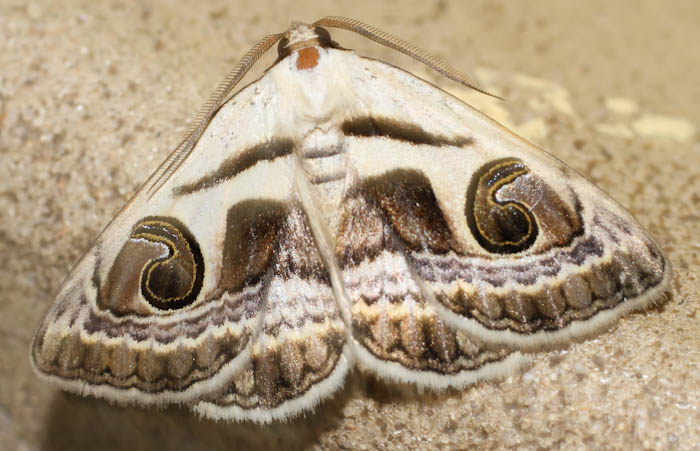 © Super Mongoose
© Super Mongoose
Marakele National Park, Bontle campsite's bathroom
Description
Wingspan about 30 mm. Antennae of male bipectinate; all the tibiae spined. Fore wing grey-white, the basal and costal areas irrorated with brown; the costal edge dark brown towards base; a slight oblique waved subbasal line from costa to' submedian fold; antemedial line black-brown, slight and acutely angled outwards in npper angle of cell, then forming a narrow band, very oblique to inner margin near base where there are a few silvery blue scales on it; a large inverted comma-shaped discoidal mark, its centre black with some red-brown at middle.
Distribution
Botswana, DRCongo, Malawi, Mozambique, South Africa, Zambia, Zimbabwe.
Links: African Moths
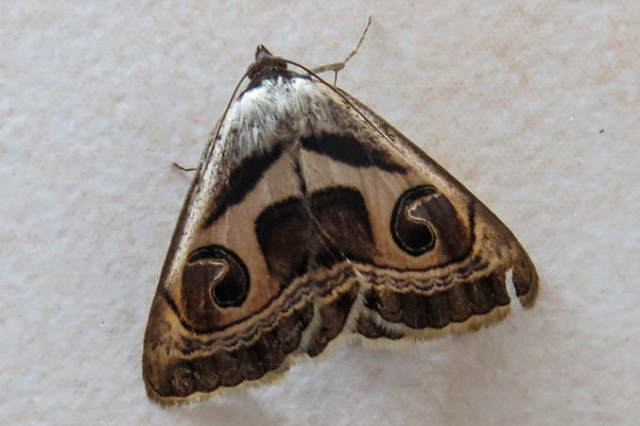 © steamtrainfan
© steamtrainfan
Pilanesberg, Manyane
Family: Noctuidae. Subfamily: Catocalinae
or: Family: Erebidae. Subfamiy: Ebreinae
 © Super Mongoose
© Super MongooseMarakele National Park, Bontle campsite's bathroom
Description
Wingspan about 30 mm. Antennae of male bipectinate; all the tibiae spined. Fore wing grey-white, the basal and costal areas irrorated with brown; the costal edge dark brown towards base; a slight oblique waved subbasal line from costa to' submedian fold; antemedial line black-brown, slight and acutely angled outwards in npper angle of cell, then forming a narrow band, very oblique to inner margin near base where there are a few silvery blue scales on it; a large inverted comma-shaped discoidal mark, its centre black with some red-brown at middle.
Distribution
Botswana, DRCongo, Malawi, Mozambique, South Africa, Zambia, Zimbabwe.
Links: African Moths
 © steamtrainfan
© steamtrainfanPilanesberg, Manyane


